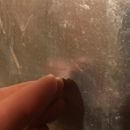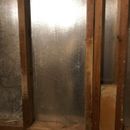Is this a vapor-permeable air barrier?
1960’s home… wall construction is as shown, with face brick on the back side. Silver faced material is thin (maybe 1/8″ thick).
I did not notice originally, but in good light, once can see what may be perforations in the surface.
Does anyone recognize if this is a vapor permeable sheathing material?
GBA Detail Library
A collection of one thousand construction details organized by climate and house part











Replies
Ross,
If you can see perforations, this product is probably a product usually described as a "perforated radiant barrier." The perforations are supposed to increase the vapor permeance of the product.
According to a web page published by a manufacturer of this type of product (Radiant Guard), "A perforated radiant barrier has small holes throughout the product that allow moisture vapor to pass through. Per ASTM C1313, the permeance of the material shall exceed five (5) perms as determined with Test Methods e96/e96M (Procedure A—Desiccant Method). RadiantGUARD Ultima-FOIL Breathable has a permeance of 8.5 perms; above the required minimum."
All of that said, it's difficult to know the vapor permeance of a product installed in the 1960s. The best we can do is guess.
Concerning the second aspect of your question -- "Is it an air barrier?" -- I wouldn't put much faith in this product as an air barrier. There is probably a lot of leakage at the perforations, at the seams, and at the perimeter of this product. If I were you, I would plan to use something else as my air barrier.
It sure seems like it is probably permeable, but didn't know if specifics were known for products like this of that age. That's a good reference - thanks for sharing and the feedback!
Typically perforated foil facers are in the ~5 perm range give or take a few. But the vapor permeance of the materials it's laminated onto will vary by quite a bit. Foil faced fiberboard's vapor permeabilty is effectively determined by the perforated facer, but with plywood or foam board the core materials matter. Most foil faced radiant-barrier roof decking has similar (usually more and bigger) perforations on the facer to allow the decking to dry toward the interior, but it doesn't increase the vapor permeabilty of the decking itself.
eg: https://lpcorp.com/products/panels-sheathing/radiant-barrier-roofing/
If it's only 1/8" thick the sheathing isn't structural. It is probably a material designed to limit the high moisture drive of sun on wet brick from raising the cavity quickly and condensing during the cooling season, while still allowing some drying toward the exterior. From the appearance of the hole sizes and spacing would suspect the facer is less than 5 perms, maybe under 3, but definitely over 1. It might be worth removing a square inch somewhere for dissection closer inspection (it can later be taped-over with aluminium duct tape to avoid the big hole). It could be just heavy asphalted cardboard, or something else entirely.
There is some rotted out section. To me, it seems to be something like a thick paper board... maybe a bit more rigid, but probably closer to 3/32 thick. You can see some of the layers in the pic.